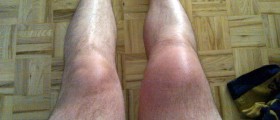
Septic arthritis is a medical condition characterized by inflammation of joints caused by bacterium other than Neisseria gonorrhoeae. The infection of joints which develops due to the previously mentioned microorganism has different clinical characteristics than typical septic arthritis caused by other infective agents.
Septic Arthritis: Causes
The infection of joints occurs once the bacteria enter the bloodstream and reach the particular joint. One more possibility is direct infection that develops after a joint injury or develops as a side effect of joint surgery. In majority of cases septic arthritis affects either the hip or the knee joint.
Septic arthritis can be classified into acute and chronic. Acute septic arthritis most commonly develops due to Staphylococcus or Streptococcus infection while chronic form of the disease (which is not so common as acute septic arthritis) is generally associated with Mycobacterium tuberculosis and Candida albicans.
Some individuals are more susceptible to septic arthritis. The problem is more frequent among patients with artificial joint implants, those suffering from bacterial infection of other parts of the body and patients with chronic illnesses. The risk also increases in case there is intravenous or injection drug use, a person receives medications that suppress his/her immune system and in people who have recently experienced joint trauma/injury. Surgery and some diagnostic procedures (arthroscopy) may also contribute to the disease.
Septic Arthritis: Clinical Characteristics
The affected joint is inflamed, swollen, and a source of intense pain. Some patients may develop low-grade fever. In newborns and infants the pain is intensified during movement of the infected joint which leads to crying and irritability. Children also develop fever. Inability to move the affected joint is one more characteristic of the disease.Septic Arthritis: Diagnosis
Patients undergo thorough physical examination and the doctor investigates their medical history. It is also important to conduct some tests such as blood culture, joint fluid analysis and culture and take X-ray of the affected joint. All these are of great help in confirmation of the infection.Septic Arthritis: Treatment
Once the infection is confirmed, patients are prescribed antibiotic that is effective against the bacterium that has led to arthritis. The treatment must be aggressive in order to eradicate the infective agent and prevent potential complications.
Additional measures include bed rest and elevation of the infected body part. In patients in whom synovial fluid accumulates rapidly inside the joint, doctors may perform aspiration. More complex cases require surgical drainage of the infected joint fluid.
Majority of patients completely recover thanks to potent antibiotics. Not many may end up with complications such as permanent joint degeneration.


-Arthritis_f_280x120.jpg)








-Symptoms,-Diagnosis,-Treatment_f_280x120.jpg)

-Symptoms,-Diagnosis,-Treatment_f_280x120.jpg)



Your thoughts on this
Loading...